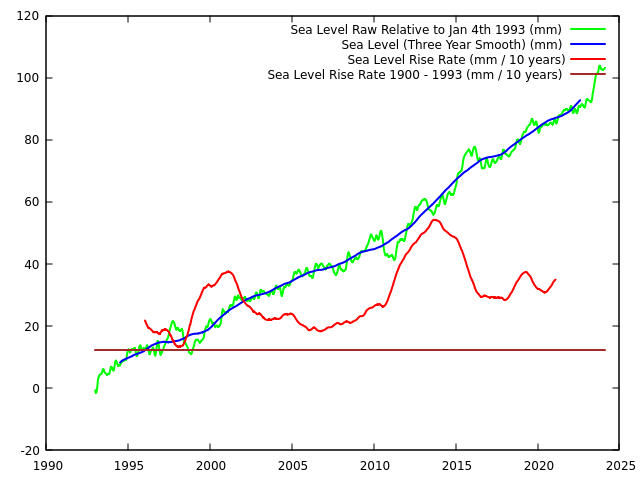The same page goes on to clarify that there's a lot of
uncertainty in that huge land-based ice sheets in Greenland
and Antarctica can very suddenly, catastrophically
and unpredictably let
go and go sliding into the sea, resulting in substantial
sudden increases in sea level.
1.55" per decade may not sound like much, but it could
be radically worse, and even at that level, during
storms, sea level can rise several feet, so those extra
inches can make all the difference between being flooded
and staying dry. When hurricane Sandy hit New York City,
sea level rose several feet and sea water was able to flow
into subway stations and flood subway tunnels, destroying
the electronics inside. The tunnels of the 'L'
and 'R'
subways between Manhattan and Brooklyn were flooded,
causing a partial shutdown of of the 'L' and a total
shutdown of the 'R' for about a year.
Since the AR6 report, scientists have been concerned that
certain glaciers may be closer to a
catastrophic breakdown than was
previously supposed.
Due to warming, the ice on the surface of the ice sheet
melts and forms pools of water. The melted water is
denser than ice and burrows down through it,
forming vertical tunnels. The water keeps
drilling down until it reaches the rock under the glacier
where it forms pools. The ice is still resting directly
on rock in most places, so the glacier isn't floating, but
there are ever-growing pools of water between the ice and
the rock, melting the ice at the bottom or turning it to
slush. At high tide, sea water comes into the pools
through the tunnels, and
at low tide, the pressure of the sea water is less so water
flows from the pools through the tunnels to the sea, so
there's all this salt water sloshing back and forth around
the bottom of the glacier ice, melting it and lubricating
it, and scientists really don't know how to predict
exactly when the whole glacier will suddenly let go and
slide into the ocean. So the level of sea level rise
could be much more than projected.
